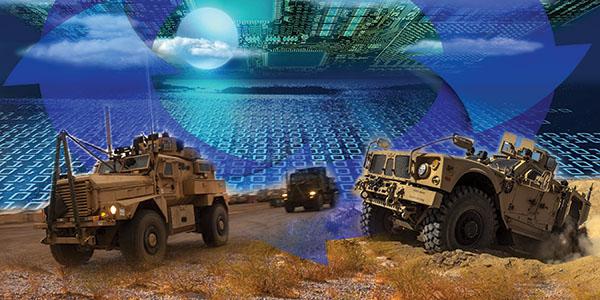Wanted: Chief Information Warfare Officer
The U.S. Defense Department must move aggressively to better understand information warfare and its implications to national security. To propel the necessary next steps, the department must organize information resources not only to meet military cyberspace requirements but also to address how adversaries view U.S. cyber assets.
Although the nation has long dominated the communications and information systems landscape, past success makes it vulnerable in the future. Consequently, forces and the weapons platforms they rely on are increasingly susceptible to information attacks.
One approach to addressing this threat is to simplify and combine similar information functions under a chief information warfare officer (CIWO). This single step would enable the military to make rapid progress toward full and integrated decisive operations in the information environment.
Adversaries clearly understand that information has become the new currency of comprehensive national power and have organized around this construct. To counter this tactic, U.S. thinking needs to change from centering only on kinetic warfighting platforms to elevating nonkinetic enablers that harmonize symbiotically with kinetic warfighting platforms. This will allow for accelerated, high-quality and secure decision making by giving military leaders cyber choices on par with kinetic options.
Nearly two decades ago, the U.S. military embraced network-centric warfare, propelling the United States to become a more lethal and powerful military force. However, the military’s new strategy invited enemies to wage war via nontraditional means. As strategists Gary Hamel and C.K. Prahalad stated in “Strategic Intent,” a 2005 article in the Harvard Business Review, “The most effective weapon [our adversaries] possess is a clean sheet of paper. And an incumbent’s greatest vulnerability is its belief in accepted practice.”
The United States views cyberspace as a global commons where the free exchange of information can be fostered. Adversaries view it as a place where the government can exercise its sovereign prerogatives. As a result, cyberspace is a platform for a war of information with related technologies as the critical enablers, and the United States cannot continue driving into the future using its rearview mirror.
Developing a coherent strategy and organization can be transformative. To accomplish this task, the Defense Department will need to provide the means and muster the will to adapt. Just as Hamel and Prahalad developed the Core Competence Model to help companies better understand how to take advantage of markets, the department must view information as a core competency writ large.
Although the department holds the role of information in warfare in high regard, its actions over the past two decades have led to a structural devolution in the data domain. For example, in 2003, the responsibilities of the Assistant Secretary of Defense for Command, Control, Communications and Intelligence (ASD C3I) were divided between different undersecretary and assistant secretary offices and the chief information officer (CIO). In 2012, responsibilities of the latter organization was further split into the Deputy Assistant Secretary of Defense for C3, Cyber and Business Systems, the CIO and the Defense Information Systems Agency.
The organizational changes have made it difficult to provide the reliable, timely and secure information that underpins all United States operations. The seemingly simple fracturing of the ASD C3I added complexity to coordination, which increases time to task completion and reduces agility. No bright line divides enterprise network operations from warfighting weapons and systems.
Today, however, the department’s stance is shifting. The 2017 National Defense Authorization Act (NDAA) directs the department to examine an improved organization for cyber operations and information management. The NDAA also directs separation of the Undersecretary of Defense for Acquisition, Technology and Logistics into an Undersecretary for Acquisition and Sustainment and an Undersecretary for Research and Engineering.
In addition to the 2017 NDAA directive, the April 2017 Defense Science Board Task Force on Military Communications and Tactical Networking recommended the reestablishment of an ASD C3I. Putting information on par with the other warfighting capabilities will greatly facilitate employment of the power of information and its integration with kinetic capabilities.
These structural changes give the Defense Department the opportunity to change the way it thinks about data and information. They enable the department to make the necessary organizational and process realignment to enter the information age and fully integrate kinetic and non-kinetic effects for superior mission outcomes. And, it is fully consistent with the Defense Secretary’s elevation of information to a joint warfighting function.
These adjustments also require a comprehensive solution that reduces bureaucracy, aligns accountability and authority, and synchronizes resources. They will maximize value by empowering and developing the information, communications, influence, technology, software and cyber workforces.
In view of the current resource- and personnel-constrained environment, it is imperative to consolidate, synchronize and harmonize talent so the department can focus on critical information-sharing enablers and ensure it continues to provide U.S. warfighters with a decisive advantage. This is an opportunity to review the core competencies that are essential to achieving kill chain results.
Absent this focus, the United States devalues the department’s investment in multibillion-dollar platforms and hampers its ability to achieve targeted mission objectives. Increasing attention on critical information enablers—both technology and people—is necessary not only to enhance offensive capabilities but also to limit adversaries’ ability to leverage the same technology and gain an asymmetric advantage.
By establishing a CIWO office, the department could dedicate talent to achieving significant results in these areas to maintain a decisive edge. Nonkinetic warfare enablers such as spectrum, precision navigation and timing, electronic warfare, and information warfare and operations are growing in importance to military missions.
A CIWO would provide a pathway to defining coherent strategies that recognize the interdependencies and relationships between and among information operations and warfare. It also would bring focus to enterprise and tactical networks; cyber defense and offense; electronic warfare; nuclear C3; tactical C3; precision navigation and timing; radio spectrum; data architectures and management; software criticality; and integration and interoperability.
With civilian oversight of the U.S. Cyber Command, the chief information warfare officer would be the chief data officer and the Defense Secretary’s principal staff adviser for all cyber information management, cybersecurity and matters associated with operating the defense information environment.
The CIWO would serve as the principal staff assistant of spectrum matters within the department, nationally and internationally. This responsibility would include establishing policy and overseeing its implementation. In addition, a chief information warfare officer would provide direction and guidance for all Defense Department matters related to the electromagnetic spectrum and the government’s spectrum management policies and electronic warfare.
In coordination with the Undersecretary of Defense for Intelligence, the CIWO also would provide guidance on spectrum management and use by intelligence, surveillance and reconnaissance sites, platforms and activities. All statutory requirements of the current chief information officer would move to the new chief information warfare officer.
The CIWO would function as the Overarching Integrated Product Team lead for the acquisition of software-intensive and major communications and information system technology programs. In this role, the chief information warfare officer would report to the Undersecretary of Defense Acquisition and Sustainment as the ultimate milestone decision authority for acquisition.
Five directorates would be established under the Office of the CIWO: Information Warfare and Nonkinetic Enablers; Command, Control, Communications and Computers (C4); Data and Software; Special Programs; and Space. The Information Warfare and Nonkinetic Enablers Directorate’s functions would include oversight, coordination and end-to-end integration and interoperability of information warfare and information operations, electronic warfare, precision navigation and timing, cyber effects and cyber force generation.
The C4 Directorate’s responsibilities would include oversight, coordination and end-to-end integration and interoperability of nuclear C3, command and control, tactical communications and networks, radio spectrum, cyber mission forces development and enterprise operations, including the Department of Defense Information Network.
The Data and Software Directorate would oversee, coordinate and ensure the end-to-end integration and interoperability of data architectures, information security, software assurance and methods, Defense Digital Services, business systems and analytics. This directorate would function as the assistant chief data officer for the department.
The Special Programs Directorate would take its cue from the fighter pilot’s mantra: Speed is life. The pursuit of speed is critical because changes occur even more rapidly in cyberspace. This group would advance novel concepts in the information space as well as provide quick reaction to national security problems independent of service equities.
Space operations are a key determinate of who is likely to dominate the information environment. At the end of the day, space is simply a place to collect or transport information. Consequently, the Space Directorate would be responsible for governance of this key terrain that is critical in information warfare.
In this notional structure, billets and funding for the new office would come from the current Defense Department information, acquisition, cyber and space organizations, so it would be a net-zero organizational billet change. The overarching theme would be to shape the information enablers across the department with a goal of continuously improving them to facilitate desired departmental changes and amplify warfighting effects.
Agility is key to maintaining an active and responsive information operations strategy. While the means and methods of communication have changed over the past few decades, much of the U.S. government thinking about the information environment has remained the same. Restructuring to eliminate redundancies and improve communications among the information stakeholders provides clarity and simplicity that will propel the organization.
The future is digital, data-centric, software intensive and distributed. Information is both a resource and a weapon. An information advantage is paramount to achieving a tipping point in national security outcomes. Exploiting the volume, velocity, variety, veracity and value of data the department collects is necessary for survival in the information age. The military’s ability to collect, analyze, push and pull information will be its competitive advantage.
George Duchak is a senior fellow at George Washington University’s Center for Cyber and Homeland Security.







Comments